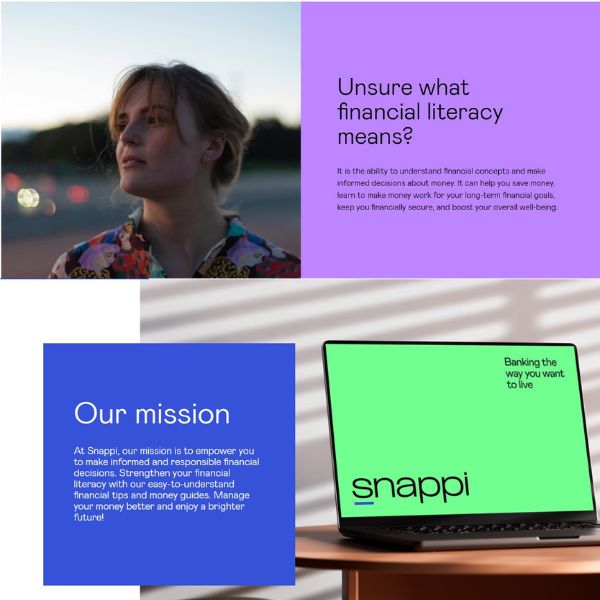Neobanks were born as a reaction to clunky branch-based banking. Sleek apps, swift sign-ups and a promise to make banking simple. That promise is only half the battle. In an era of rising economic anxiety and headline-grabbing compliance missteps, customers don’t just want convenience, they want confidence. Educational hubs are the single most under-used lever that can convert curiosity into trust, and casual users into loyal customers. Let’s look at how educational hubs drive customer trust for neobanks.
Trends In Neobank Content Marketing
When neobanks first exploded onto the scene, their marketing playbook was product-led: flashy UX, low fees, and quirky brand work. Today, the leading players are pivoting. They’re investing in explanations, clarity and personalised guidance because product features alone no longer cut it. Customers want personalised, actionable help with real-life money choices.
Accenture’s 2025 Global Banking Consumer Study shows that banks that address individual frustrations and life moments generate stronger customer advocacy.

Content is also moving beyond blog posts. Marketers are layering short-form video, interactive tools, calculators and tailored email funnels to meet customers where they are. And the industry is responding with major marketing studies showing an uptick in investment in content strategies and AI-enabled distribution to personalise messages at scale.
What Do Bank Customers Want To See In 2026?
Customer priorities are changing fast, and the data is clear:
- A large and growing share of banking customers now say they want personalised advice and guidance from their financial providers; personalised guidance increases satisfaction when it is truly tailored to the customer’s situation.
- Global banking consumers are telling banks to go beyond transactional services and address their life needs. Accenture surveyed tens of thousands of customers and found that customers who feel their bank understands them are far likelier to advocate for it.
- Neobank adoption is still on a strong growth curve. Several market estimates forecast hundreds of millions of neobank users worldwide within this decade, underlining the scale of opportunity for educational content that converts new users into active customers. Check out the Statista projections and market analyses summarising this growth trajectory.
- Financial vulnerability and the need for advice are also rising. A recent industry survey reported a marked increase in customers who say they are “very interested” in receiving bank-led advice or guidance compared with earlier years – a clear signal that education will be a differentiator.
Put simply, people want personalised, practical help, not just product copy. A robust educational hub answers that need and becomes a measurable engine of trust.
Contentworks Agency worked with neobank Snappi to strategise and execute a branded approach to their education hub, delivering valued content to clients.

What Does An Educational Hub Look Like?
An educational hub is more than a blog. Think of it as a purpose-built learning ecosystem that maps content to customer journey stages, product lines and local market realities.
Core elements (high level):
- Tiered learning paths: Beginner → intermediate → advanced. A new-to-banking customer sees “Getting started” explainer content; an intermediate saver sees guides on optimisation; a more sophisticated customer finds deep dives on investments and tax nuances.
- Product-linked learning: Content modules mapped to product pages (e.g., “How credit works” beside a credit product; “How FSCS protection works” beside deposit products).
- Regional and regulatory localisation: Local rules, deposit insurance thresholds and tax implications differ by market; the hub must reflect local language, examples and compliance notes.
- Formats: Long-form guides for SEO and depth; short explainers and animated videos for social; interactive calculators and checklists for decision-making; email series’ and push-notifications for retention.
- Audience targeting: Segmented pathways for students, gig-economy workers, SMEs and mass retail customers; different tones and CTAs per segment.
- Measurement & compliance layer: Clear versioning, legal sign-off on financial claims and an analytics stack to tie content engagement to product metrics.
Pro tip: You don’t need a different product for every article. You need clarity about who each asset is for and what action it should nudge the reader toward.
How Educational Hubs Drive Growth
Educational hubs are not just “nice to have” brand assets. They have direct commercial impacts.
Increased engagement through blogs, guides and explainer videos
Customers who engage with helpful content spend more time in-app, open more sessions and are more likely to explore additional features. Content Marketing Institute and HubSpot data both show that high-quality content drives measurable engagement and that marketers continue to prioritise content investment.
Linking education hubs to conversions
When a hub offers product-tied learning, e.g. a short course on “How to choose a savings account” with a clear path to open an account, click-through and conversion rates improve because the user feels informed and confident. Whether its account openings, deposits or cross selling, Contentworks has worked with multiple fintechs to design learning journeys that map explicitly to conversion funnels.
Pro tip: Don’t underestimate the importance of micro-commitments (e.g., “save this checklist”), and follow-up nudges to maximise uptake.
If you’d like help building that funnel, Contentworks Agency can design and implement education-led conversion paths, from content strategy through production and measurement.
Boosting SEO and brand authority
Pillar-cluster content, how-to guides and data-led explainers attract high-intent search traffic and backlinks. Over time, a well-structured hub improves domain authority and drives organic acquisition. Hugely important in a competitive industry like finance where trust and quality content are rewarded by search engines.
Simplifying complex products
Neobank products (subaccounts, instant FX, BNPL tie-ins) are technically simple but psychologically complex. Educational hubs translate complexity into clear steps and decision trees, lowering the cognitive load for customers and making product adoption easier.
Empowering customers with financial literacy and reducing churn
Customers who understand their products are less likely to abandon them after a negative event; education increases product stickiness. Academic and industry studies on churn and banking behaviour show that better-informed customers tend to be more engaged and predictable.
Creating transparency and reducing scepticism about neobanks
Transparency reduces perceived risk. An open hub that explains fees, KYC, data handling and regulatory protections demonstrates ethical intent and when customers see that, trust follows. Financial-soundness and transparency are core trust attributes consumers assess before committing their money.
At Contentworks we offer content strategy, multilingual copywriting, short-form video production and SEO-led editorial calendars tailored for neobanks. We pair compliance-friendly narratives with measurable conversion so your hub isn’t just informative, it’s revenue-driving. Contact our team to discuss a tailored education hub built around your specific offerings and targeted clientele.
Best Practices For Neobank Education Hubs
There are many ways to do this wrong; a few things to get right:
- Clear, jargon-free content: Write like a human. Finance content must be precise and compliant, but it should never be alienating. Testing copy with real users and running readability checks prevents language from becoming a barrier.
- Multilingual / localised resources: Global apps need local voices. Translation alone isn’t enough. Here’s a small tip – adapt examples, currency units and regulatory points to local markets. Localised content increases trust and conversion in new markets.
- Gamified formats: Short quizzes, progress bars, certificates and small rewards (e.g., fee waivers after a course completion) increase completion rates and deepen engagement. Gamification also creates natural micro-commitments that lead to product trials. Read more about gamification in finance here.
- Consistency and compliance: Maintain an editorial style guide and a legal review workflow. Version control, dated updates and clear authoritativeness signals (author by-lines, methodology notes, reputable sources) are essential, especially when content discusses investments, credit or tax.
The Best Time to Build Your Educational Hub is Now
Neobanks started by solving convenience. The next frontier is trust. For neobanks that want to keep growing without sacrificing credibility, education is not an optional extra, it’s a strategic necessity. Contentworks Agency specialises in building education-first content ecosystems for financial brands. We’ve created targeted learning resources, multilingual hubs and conversion-led editorial programmes for global banks and challenger neobanks. We combine compliance-aware copy, SEO and short-form video to boost trust and measurable growth. Ask for a free strategy zoom to get started.
